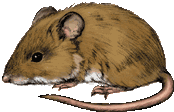|

Family Cricetidae
The family Cricetidae includes small-to-medium-sized rodents (2 to 10 inches long) except for the muskrat, which
may reach 14 inches. Most have four toes on the front feet, some have five, but all have five toes on the hind
feet. Tails are covered with hair but not bushy. Some members (mice and rats) have large eyes and ears, and long
tails. Others (voles) have small eyes and ears, and short tails. They live in a wide variety of habitats and there
is no place in the Central Rockies that does not have one or more members of this family present.
Deer Mouse
Peromyscus maniculatus
Description: Grayish to reddish brown above; tail sharply bi-colored-dark above, white below; 21/2 to 4 inches
long; 2-to-5-inch tail; 1/2 to 11/4 ounces.
Similar Species: White-footed mouse-tail not sharply bicolored. Canyon mouse - extremely long tail, fur long. Brush
mouse - extremely long tail. Pinion mouse and rock mouse-large ears; sharply bicolored tail.
Habitat/Distribution: The most widely distributed and common Peromyscus in the region. Virtually every dry-land
habitat within the region-forests, grasslands, and mixed habitats. Common to abundant throughout the region and
in RMNP.
Food: Lives on seeds, nuts, and insects. Will store food when excess is available.
If adaptability to its habitat is the animal criterion for success, then the deer mouse is the most successful
animal in the region. Even though it is the most abundant and widespread mammal in the Rockies, it is active primarily
at night and so is seldom seen. They build their nests in burrows in the ground, beneath rocks, in logs, trees,
buildings, or almost any other protected area. They forage home ranges that may vary in size from one-third acre
to over three acres. Although they do store some food, this instinct is not as strong in the deer mouse as it is
in some of the other mice.
They breed from April to September. Because females are polyestrous and go into heat after giving birth, they are
pregnant almost constantly during the warm part of the year. Litter size varies from one to nine, usually five.
Gestation, usually 24 days, extends to 34 days if the female is lactating. Young females will breed at four weeks,
males at six weeks.
Because of their abundance, deer mice are an important part of the Central Rockies ecosystems. They provide food
for both mammalian and avian predators. Even if they manage to escape predators, they rarely live over two years
in the wild.
|